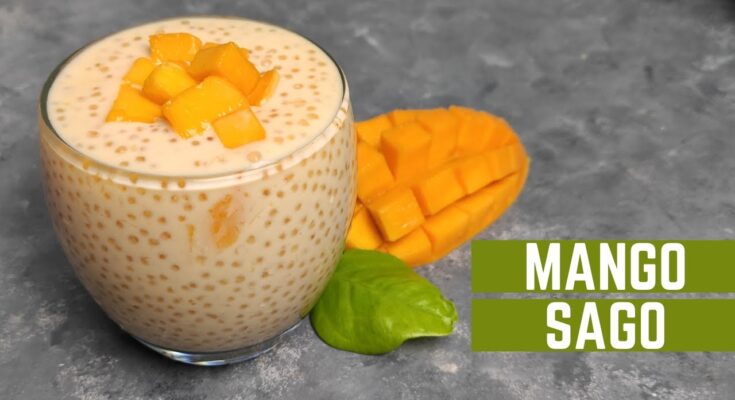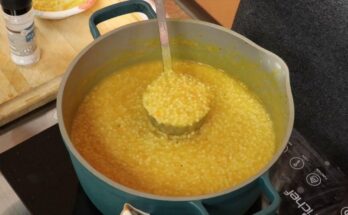Mango Sago Recipe: Mango Sago is a beloved Asian dessert, especially popular in Hong Kong, Taiwan, and Southeast Asia. It’s a luscious, refreshing treat made with juicy mangoes, chewy sago pearls (small tapioca balls), and creamy coconut milk. Imagine a tropical explosion of flavors, creamy, fruity, and wonderfully textured. It’s the perfect dish to impress your friends or simply enjoy on a lazy afternoon!
Why Mango Sago is a Perfect Dessert
Why do people love Mango Sago so much? Simple—it’s light yet satisfying, sweet but not overpowering. Plus, it’s visually stunning with its vibrant yellow color and pearl-like sago scattered throughout. It’s easy to prepare, requires no baking, and is extremely customizable based on your taste. Whether you’re hosting a party or just treating yourself, Mango Sago is always a hit.
Ingredients Needed for Mango Sago
Fresh Mangoes
Mangoes are the star of this recipe, so choosing the right ones is key. Opt for ripe, sweet varieties like Ataulfo, Honey, or Alphonso mangoes. You’ll need about 2-3 medium-sized mangoes, depending on their size. Ensure they are fragrant, slightly soft when pressed, and free of black spots.
Sago Pearls
Sago pearls are tiny, chewy balls made from tapioca starch. They add a delightful texture to the dish. You’ll need about 1/2 cup of uncooked sago pearls. They are widely available in Asian grocery stores and sometimes labeled as “small tapioca pearls.”
Coconut Milk and Other Essentials
Coconut milk adds richness and a subtle tropical note. Full-fat coconut milk is preferable for a creamy consistency. Besides coconut milk, you’ll also need:
- 1/4 cup sugar (adjust based on mango sweetness)
- 1/2 cup water
- Ice cubes (optional for serving chilled)
- Mint leaves for garnish (optional)
Step-by-Step Guide to Making Mango Sago
Preparing the Sago
Start by boiling water in a pot—at least 4 cups of water for 1/2 cup of sago pearls. Once the water is boiling, slowly add the sago while stirring continuously to prevent clumping. Let it simmer for about 10–15 minutes until the pearls turn mostly translucent with a tiny white dot in the center. Turn off the heat and cover the pot, letting it sit for another 5–10 minutes until fully translucent.
After cooking, rinse the sago under cold running water using a sieve. This stops the cooking process and removes excess starch, keeping the pearls from sticking together.
Preparing the Mango Puree
While the sago cools, peel and dice the mangoes. Set aside a small portion of diced mango for garnishing later. Place the rest into a blender or food processor along with 1/2 cup of water and sugar. Blend until smooth. If your mangoes are very sweet, you might want to skip or reduce the sugar.
Taste the puree. If it’s too thick, add a little more water or coconut milk to thin it to your desired consistency.
Assembling the Dessert
Now comes the fun part: assembling! In a large bowl, combine the cooled sago pearls with the mango puree. Gently stir in the coconut milk, tasting as you go. Adjust the sweetness or creaminess by adding more sugar or coconut milk if necessary.
Spoon the mixture into serving bowls or glasses. Top with the reserved mango cubes and a sprig of mint for an extra pop of color. You can chill it in the fridge for about 30 minutes if you prefer it cold or serve it immediately with a few ice cubes.
Tips for Perfect Mango Sago
Choosing the Right Mangoes
Always go for ripe, aromatic, and non-fibrous mangoes. The sweeter and juicier the mango, the better your dessert will taste. Avoid stringy varieties that might ruin the texture of the smooth puree.
Cooking Sago Properly
Patience is key when cooking sago. Don’t rush the simmering process, and remember to stir continuously at the start to prevent clumping. After boiling, resting the sago off-heat allows it to become fully translucent without overcooking.
Sweetness Adjustment Tips
Every mango is different. Some are super sweet, and others a bit tart. Always taste your mango puree first before adding sugar. Adjust to your preference—you want the natural mango flavor to shine without being overly sweet.
Variations and Serving Suggestions
Different Flavor Additions
You can get creative with your Mango Sago by adding other fruits like strawberries, lychees, or passion fruit. A splash of condensed milk can also make it richer, while a squeeze of lime adds a zesty twist.
How to Serve Mango Sago
Mango Sago can be served warm, at room temperature, or chilled. Most prefer it cold, especially on a hot day. To take it up a notch, you can even layer it parfait-style with whipped cream, extra fruits, or crunchy granola.
Creative Twists on Traditional Mango Sago
Incorporating Other Tropical Fruits
If you’re feeling adventurous, you can enhance the traditional Mango Sago by adding other tropical fruits. Think of fruits like:
- Pineapples
- Lychees
- Kiwi
- Dragon fruit
Dice these fruits into small cubes and fold them gently into the finished Mango Sago mix. This will not only add an explosion of colors but also a variety of flavors and textures, making the dessert even more exciting.
Layering with Jelly
Another creative twist is layering the Mango Sago with coconut jelly or grass jelly. To do this, prepare your favorite jelly in advance and cut it into cubes. In serving glasses, layer the jelly cubes, followed by Mango Sago, and top with extra mango cubes. This adds an unexpected texture and makes the dessert look stunning for parties and gatherings.
Nutritional Value of Mango Sago
Calories and Nutrients
While Mango Sago is undoubtedly delicious, it’s also good to know what you’re eating. Here’s a rough breakdown per serving:
| Nutrient | Approximate Value |
|---|---|
| Calories | 250-300 kcal |
| Carbohydrates | 40-50 g |
| Fat | 7-10 g |
| Protein | 2-3 g |
| Fiber | 2-3 g |
Mango provides vitamin C and fiber, while coconut milk offers healthy fats. However, because of the sugar and starch from sago, it’s best enjoyed in moderation if you’re watching your calorie intake.
Common Mistakes to Avoid
Overcooking the Sago
One of the most common pitfalls is overcooking the sago until it becomes mushy. Always remove the sago from heat when it’s still slightly opaque in the center, then let it sit covered to finish cooking. This method ensures perfectly chewy pearls every time.
Using Unripe Mangoes
An unripe mango will completely throw off the taste of your Mango Sago. It will be sour, hard, and not blend smoothly. Always check your mangoes by smelling them; ripe ones have a fragrant, sweet aroma.
Skipping the Rinse Step
After boiling, rinsing the sago under cold water is crucial. Skipping this step will leave you with a sticky, clumped mess rather than beautifully separated, chewy pearls.
Make-Ahead Tips for Mango Sago
Preparing Components Separately
You can easily prepare the different components a day ahead:
- Cook the sago and store it submerged in water in the fridge.
- Make the mango puree and refrigerate it separately.
- Assemble everything just before serving to ensure the best texture and freshness.
Storage Recommendations
Mango Sago is best consumed within a day of making it. If you must store leftovers, place them in an airtight container and consume them within 24 hours. The sago tends to absorb liquid and swell over time, altering the texture if kept too long.
FAQs about Mango Sago Recipe
1. Can I use canned mangoes for Mango Sago?
Yes, you can use canned mangoes if fresh ones aren’t available. Just make sure to drain the syrup and slightly reduce the sugar in your recipe to balance the sweetness.
2. How do I prevent the sago from sticking together?
Rinse the cooked sago pearls under cold running water immediately after boiling. This stops the cooking process and keeps them from clumping.
3. Can I make Mango Sago ahead of time?
Absolutely! Mango Sago tastes even better after chilling. You can prepare it up to a day in advance and store it in an airtight container in the refrigerator.
4. Is Mango Sago gluten-free?
Yes! Sago (also known as tapioca pearls) is naturally gluten-free, making Mango Sago a perfect dessert for those avoiding gluten.
5. What can I substitute for coconut milk?
If you don’t like coconut milk, you can use regular milk, evaporated milk, or almond milk for a different but delicious twist.
Conclusion
Mango Sago is more than just a dessert—it’s a celebration of summer’s best flavors! Creamy, fruity, and delightfully chewy, it’s a crowd-pleaser that never disappoints. Plus, it’s incredibly easy to customize and whip up with just a few basic ingredients. Whether you’re cooling off on a hot day, treating guests, or simply craving something sweet and tropical, Mango Sago will hit the spot every single time. With this easy, step-by-step guide, even beginners can master this Asian classic right in their kitchen. So grab those ripe mangoes and get started—you’ll be amazed at how delicious homemade Mango Sago can be!



